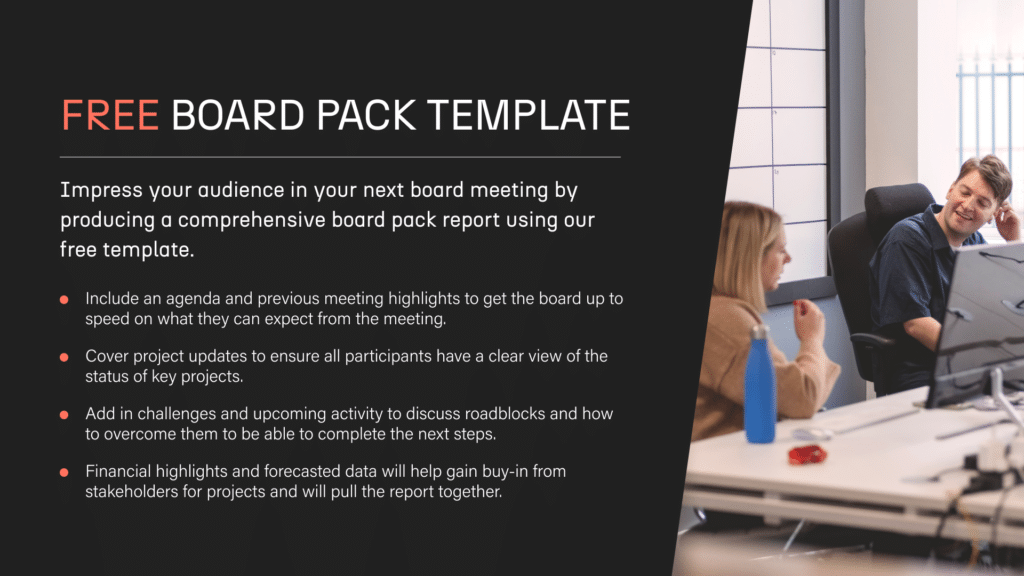How to Create a Board Pack Report and What to Include
Need to secure buy-in for an upcoming digital project? Maybe your board of directors are a little nervous wherever sweeping technological change is involved – and want a little extra reassurance everything will go as you planned?
Whatever your reasons are, a board pack report is an essential document that bridges that sometimes frustrating divide between day-to-day operations and the boardroom – delivering an impactful means of highlighting the value of progressive new campaigns and activity.
In this guide, we’ll show you how to create a board pack report that communicates the what and the why of your day-to-day operations with senior stakeholders and members of the board. Use the links below to navigate or read on for the complete guide – we’ve even created a free board pack template to help you out with.
What is a Board Pack Report?
As far as a board pack meaning goes, it’s a pretty simple one to define. Basically, a board pack report is one or more reports compiled for board members to provide them with top-line stats and information. Board packs can aid with decision-making and transparency, offering a breakdown of key metrics and progress updates from all areas of a business that’s easy for others to digest.
Board reports have a highly specific purpose: to inform board members of progress, pain points, and states-of-play relating to a campaign, project, or operational area. They don’t contain granular-level detail and particulars, they’re focused more on communicating headline metrics that inform a business’ strategy and objectives.

Why Create Board Pack Reports?
There are several reasons why a business may choose to create board pack reports or request them from third parties, such as their digital marketing agency. Keep in mind, though, that every report you compile or request uses resources, so it’s important to be clear on why it’s needed, what it will achieve, and who will read it.
With that, let’s look at some of the typical reasons why you may need to create or request a board report.
- To maintain buy-in from board members – It’s the board’s job to question the effectiveness and value of day-to-day operations, so that activity aligns with the overall goals of the business. Regular board reports are a means of validating the ongoing success of a particular function, which is essential if you want to keep getting funding and operational support.
- To inform the wider business strategy – Board members are responsible for a company’s decision-making and strategy. And if they want to do that, they’ll need up-to-date and actionable insights. Board reports provide these essential metrics, cluing them into forecasting and strategising based on real-time evidence from individual departments and functions.
- To support financial goals and profitability – While digital marketing activity (as an example) contributes a lot to a company’s success, senior managers and board members aren’t too fussed about its day-to-day operations and KPIs on a granular level. Instead, they want to see that business functions like marketing are contributing to the business’ financial objectives. Board reports are a means of highlighting a department’s contributions – without going into unnecessary detail.
These are just a few examples of why businesses compile board pack reports. They’re also very common when dealing with third-party services and suppliers since they demonstrate the value of such partnerships to senior stakeholders sceptical about certain company investments and ventures.

What is Included in a Board Pack?
Now that we’ve discussed the what and the why of board pack reports, you should have a better idea of the things they typically include. Remember, these types of reports are targeted at people who may be unaware of day-to-day activities and the terminologies that go along with them, so it’s important to keep things simple, clear and to the point when compiling board pack reports.
Below, you’ll find some of the key board pack contents you should include as part of your report.
Outline the agenda
If this article is going to make anything clear about board pack reports, it’s the top-line nature of them. So first things first, you’ll want to make sure the board don’t feel like their time is going to be wasted: outline the agenda at the beginning so that they know what to expect from your report over the coming pages.
Financial highlights X, Y, Z
Up-to-date financial data tends to be front and centre of a board report, and is the primary marker of success and performance that board members will be interested in. Senior stakeholders want to see how a specific business function is contributing to revenue and profitability, so lead with financial highlights that make the value clear.
Areas of focus
What has a particular department been working on since the last board meeting, and why? Boards of directors will want to know the reasons behind current business activities and operational decision-making, getting them on board with buy-in and support as you move forward with a particular project.

Industry state of play
Leading on from the last point, it’s a good idea to include some background and context to back up your decision-making. Are there any relevant updates you can provide on the state of play within your industry that have influenced decision-making since their last meeting? How have current trends and competitor activity influenced operational activity?
Challenges, issues and pending activity
Honesty and transparency are key to a board report, so don’t shy away from listing challenges and roadblocks which may have hindered progress. A board’s duty is to take an objective view of problems and strategise solutions, freeing up resources or rubber-stamping any need for external support to help see projects over the line.
Forecasts and next steps
After outlining top-line results, potential pain points and current areas of focus, it’s time to detail your department’s next steps over the coming quarter. What projects are in the pipeline and how will they contribute to the wider aims of the business? A forecast highlighting the financial benefits of such activity will appease wary board members, offering a tangible point of reasoning they can buy in to.
Download Your Free Board Pack Template
To help you with your board pack presentation – and so your project’s momentum doesn’t lose a step – we’ve created a board pack template for you to download right here. Send over your details and we’ll send you this handy resource you can fill in with everything to keep the board of directors up to speed with what’s going on.

Tips on Creating a Board Pack Report
Compiling a board pack report isn’t difficult, but it’s important to include the right information and base any stats on up-to-date and reliable data. To help you get it right, here are a few things you’ll want to consider when creating a board pack report.
- Understand what the board wants – Boards of directors operate on a different plain to departmental managers and teams. For instance, while a success in content marketing may excite internal marketing teams, the same may not be true of board members. When reporting to a board, consider their priorities and perspective; their job is to ensure business health, financial stability, and growth. How does your activity contribute to these underlying objectives?
- Ensure solid data and sources – Given that your board pack may be used to implement sweeping strategic changes throughout the business, that any information you provide should be accurate and backed by up-to-date data. Always review information carefully before including it in your board pack, so you can be confident that everything is accurate and true.
- Make information meaningful – When compiling a board report, it’s important to consider the bigger picture – much like board members themselves. The data and insights you include need to align with the wider objectives of the business, so bring everything back to the broad-stroke issues which board members are most interested in solving.
- Avoid overdoing it on data – Including reams of data may feel like a value-add way to appease members of the board, but going overboard might muddy your message and waste resources in the process. Worse still, it might just flat out bore the board. Instead, stick to the salient facts and use charts and graphs to showcase data in an impactful and meaningful way.
- Present your board report in a clear, straightforward way – Typically, the board will decide how they want to receive a report and how it should be formatted, but if this isn’t clear, err on the side of simple. An electronic, easy-to-distribute board pack is usually the preferred way to go, but be mindful that some stakeholders are less technologically minded. You might have to bend to individual formatting and delivery needs where appropriate.
There you have it, how to go about creating board packs for board meetings. We hope this guide helps you maintain a healthy relationship with your board of directors – and secure that buy-in your project deserves. The team at BANC are an extension of our clients’ businesses, working closely with them to nail their goals and objectives. To learn more about our services, get in touch with the team today on 0345 459 0558.



